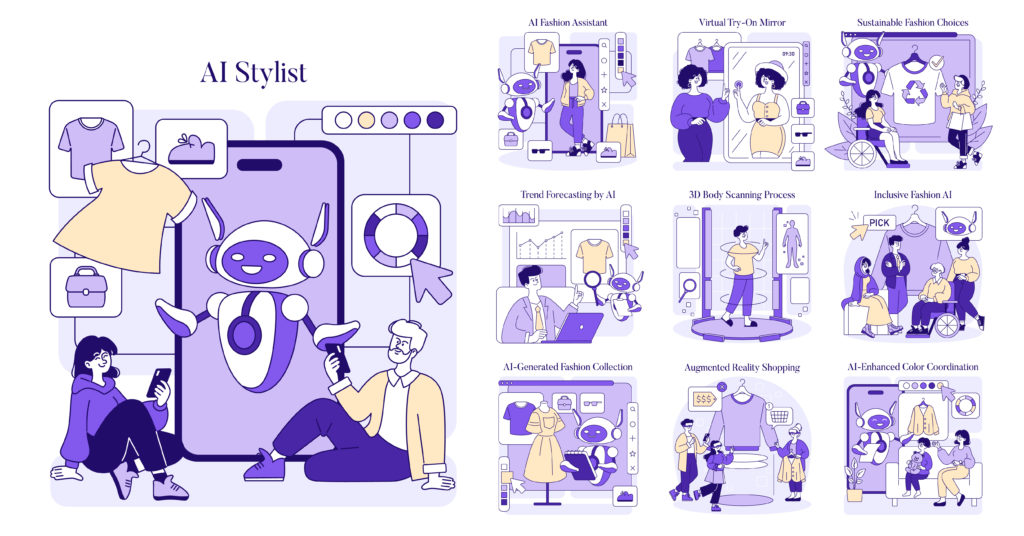- June 24 2025
Conversational AI in Ecommerce: A Simple Guide That Actually Works

Conversational AI in ecommerce spending is projected to reach $290 billion by 2025, up from $13.6 billion in 2024. This growth reflects changing customer behavior patterns. Over 60% of consumers have already used conversational AI tools like ChatGPT and Gemini for online shopping, creating new expectations for how people discover and purchase products.
According to research, 58% of these shoppers believe AI tools have improved their online shopping experiences through personalized recommendations and efficient customer support. The business impact is significant—conversational AI for sales can drive up to 30% higher conversion rates through tailored promotions and instant query responses.
Customer expectations continue to evolve. Research shows that 86% of customers are willing to pay more for a great customer experience, making conversational AI for customer service a strategic investment rather than just a technology upgrade.
If you haven’t considered implementing conversational commerce AI for your business, the data suggests it’s time to explore the possibilities. We’ve implemented these solutions for numerous clients and witnessed the practical benefits firsthand. This guide will show you exactly how to make this technology work for your ecommerce business. You’ll get actionable strategies that deliver measurable results.
Understanding the Role of Conversational AI in Ecommerce

Automated customer interactions have fundamentally changed how online stores connect with shoppers. Conversational AI in ecommerce has evolved from simple automated responses to become a critical component of modern digital retail operations.
From static chatbots to dynamic AI agents
Early ecommerce automation relied on basic rule-based chatbots that followed predetermined scripts and managed only straightforward queries. These initial systems exposed significant limitations—they frequently misunderstood customer requests, creating frustration that required human agent intervention.
Modern AI agents represent a substantial advancement. These systems can perceive their environment, process complex information, and execute specific actions toward defined goals. Unlike traditional chatbots that simply match keywords, today’s AI agents break down sophisticated tasks into manageable steps as well as execute actions across multiple integrated systems simultaneously.
How conversational commerce AI enhances CX
Conversational commerce AI creates better customer experiences through targeted personalization and operational efficiency. The technology addresses a fundamental customer pain point—92% of customers will spend more with companies that don’t require them to repeat information.
AI agents analyze extensive customer data to deliver personalized interactions that maintain brand consistency. These capabilities extend well beyond basic conversation management. AI systems can process refunds, verify account information, and send confirmation emails without human oversight. Companies implementing AI-powered virtual agents typically reduce customer service costs by up to 30% while maintaining higher satisfaction levels.
The rise of omnichannel and real-time support
Customer expectations for seamless multichannel support continue to grow—research shows 90% of consumers want consistent omnichannel experiences. Conversational ecommerce chatbots now function across websites, mobile applications, social media platforms, and messaging services like WhatsApp or Messenger.
This integrated approach ensures conversation continuity regardless of the initial contact point. Customer expectations reflect this technological capability—66% expect companies to deploy advanced technology for efficient query management across multiple channels. Modern AI systems maintain conversation context between sessions, allowing customers to switch between touchpoints without losing their interaction history or repeating previously shared information.
Building Blocks of a Successful Conversational AI Strategy
Implementing conversational AI ecommerce solutions requires strategic planning to create meaningful customer interactions. Three critical building blocks form the foundation for success.
Integrating with your ecommerce platform
Conversational commerce AI reaches its full potential when properly connected to your existing systems. Integration means embedding AI assistants into websites and mobile apps while connecting them to backend databases and APIs.
This connectivity allows AI systems to access real-time product information, inventory data, as well as order processing systems. The result is a cohesive shopping journey that feels natural to customers.
Effective integration enables conversational tools to break down complex tasks into smaller steps and execute actions across multiple systems simultaneously. Before implementation, evaluate platforms based on their ability to support your specific ecommerce ecosystem—whether Shopify, WooCommerce, or Magento.
Using customer data for personalization
Personalization drives effective conversational shopping experiences. Research shows that 78% of customers say personalization makes them more likely to repurchase because they feel the organization knows them better.
AI-driven chatbots analyze browsing history, past purchases, as well as social media activity to generate tailored product suggestions that match individual preferences. This analysis creates unified customer profiles ensuring consistent experiences regardless of which device shoppers use.
The key advantage over generic marketing is speed. AI personalization reduces decision time by showing highly relevant recommendations exactly when customers need them.
Ensuring compliance and privacy
Customer data protection has become essential for business success. With 68% of shoppers concerned about their online privacy, ecommerce conversational AI systems must adhere to regulations like GDPR and CCPA.
These protection measures build customer trust:
- Robust encryption methods for data both in transit and at rest
- Strong authentication mechanisms including two-factor authentication
- Clear data retention policies (some vendors automatically delete message data after 13 weeks)
- Explicit user consent practices for data processing
Transparency about how AI systems use customer information demonstrates your commitment to responsible AI deployment. This approach ensures legal compliance as well as enhanced reputation and stronger customer relationships.
Real-World Examples of Conversational AI in Action

Leading retail brands have moved beyond theory to implement conversational AI ecommerce solutions that deliver measurable business results. These examples show how AI-powered conversations create tangible value for companies as well as their customers.
Amazon Rufus AI Assistant
Amazon launched Rufus, a generative AI-powered shopping assistant integrated directly into the Amazon shopping app. Customers simply tap the search bar and type or speak questions to begin interacting with Rufus. The system analyzes product descriptions, customer reviews, and Q&As to provide personalized recommendations and answer specific questions.
For example, users can ask “What t-shirt can I get my 8-year-old daughter for her birthday?” rather than searching through specific size filters. This conversational shopping approach matches natural customer behavior—allowing shoppers to explore products more intuitively with questions and comparisons rather than rigid keyword searches.
Sephora’s virtual shopping assistant
Beauty retailer Sephora has developed multiple AI-powered tools that enhance the customer shopping experience. Their Virtual Artist combines augmented reality with AI to detect facial features, enabling customers to try on thousands of makeup products virtually.
The results speak for themselves. Since launching, this feature has recorded over 200 million shades tried on and attracted more than 8.5 million visits. Their AI-powered chatbot provides personalized product recommendations based on individual beauty profiles and skin concerns.
The business impact has been significant. Over 75% of daily customer inquiries are now resolved without human intervention, with response times dropping from minutes to under 10 seconds. Cart abandonment decreased by 18% among users who engaged with the chatbot during their shopping journey.
Adidas Running Shoe Finder
The Adidas AI assistant utilizes advanced machine learning to recommend running shoes tailored to each runner’s style and preferences. It provides guidance on fit, recommends performance options, and answers common questions. The AI quickly understands what runners need, improving their shopping experience.
By using Natural Language Processing, the system accurately interprets detailed training descriptions, allowing customers to describe their running habits in everyday language. This demonstrates that utilizing conversational AI for selecting footwear can yield significant business benefits when implemented effectively. The key is to focus on specific areas that directly improve customer experience and operational efficiency.
Best Practices for Long-Term Success
Implementing conversational AI in ecommerce requires thoughtful planning that extends beyond the initial setup. Businesses seeking lasting results rather than temporary improvements need a structured approach to sustained success.
Start with a narrow use case
Attempting to solve every customer pain point simultaneously creates mediocre results across all areas. Begin with high-impact, well-defined scenarios such as cart recovery, order tracking, or returns processing instead. This focused approach allows you to perfect one interaction before expanding to additional capabilities.
You’ll gather valuable performance data that guides your future development while giving your team time to optimize both technology as well as conversational tone. This strategic scaling approach prevents the common mistake of spreading resources too thin across multiple use cases.
Train your AI with relevant data
The quality of training data directly impacts your AI’s performance. Avoid over-scripting conversations, which creates robotic replies and frustrating dead-end interactions for customers.
Invest in training your AI using real customer queries, support transcripts, and frequently asked questions. This helps your conversational ecommerce chatbot understand how customers actually communicate—complete with typos, slang, and varying levels of urgency.
Schedule regular training cycles to incorporate seasonal trends, new products, and evolving customer language patterns. Your AI needs continuous exposure to fresh data to maintain its effectiveness as well as relevance.
Always offer a human fallback
Even the most sophisticated conversational AI for customer service has limitations that require human intervention. Set clear expectations from the beginning that users are interacting with a bot to maintain transparency.
Design effective escalation processes that include these elements:
- Transitions that pass full conversation context to human agents
- Agent access to complete interaction history to prevent repetitive questioning
- Monitoring systems to identify where escalations commonly occur
This human-in-the-loop approach creates a safety net that prevents customer frustration when automation reaches its limits.
Collect feedback and iterate
Conversational commerce AI requires ongoing optimization rather than a “set and forget” approach. Establish a continuous feedback loop to refine your implementation over time.
According to research, only 10% of companies actually use customer suggestions to improve their processes, despite 95% collecting feedback. Analyze what questions your AI misinterprets or struggles to answer effectively.
Track metrics like resolution time, response accuracy, and escalation rates to identify improvement opportunities. Measure the impact of changes and adjust accordingly, creating an ongoing optimization cycle that keeps your AI aligned with business goals as well as customer expectations.
Conclusion
Conversational AI in ecommerce represents a shift in how businesses connect with customers. AI-powered conversations have evolved from simple chatbots to sophisticated agents capable of handling complex interactions across multiple channels. This isn’t a magic solution that fixes everything overnight. Start with specific use cases rather than attempting to solve every customer pain point simultaneously. Train your systems with relevant data that reflects how customers actually communicate. Human fallback options remain essential for handling complex issues that exceed AI capabilities.
The future of ecommerce includes conversational AI as a core component. Customers expect seamless, personalized experiences, and AI provides the scalability needed to deliver them consistently. We’ve helped numerous clients implement these solutions and seen firsthand how they enhance customer interactions while driving measurable business results.
Conversational commerce AI requires ongoing attention to deliver sustained value. Companies that collect feedback, measure performance, and continually refine their AI systems will maintain a competitive advantage. Your journey with conversational AI may start with a simple chatbot, but with the right approach, it can evolve into a powerful tool that not only increases customer satisfaction but also drives revenue growth.
If you aim to enhance your ecommerce customer experience strategy, it’s worth considering how conversational AI can fit into your business goals. The technology has proven its value across multiple industries, and the implementation strategies outlined in this guide provide a practical roadmap for getting started. Book an AI Shopping Assistant Demo

